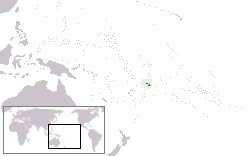Western Samoa Trust Territory
| Western Samoa Trust Territory | ||||||||||
| Sāmoa | ||||||||||
| Trust Territory of New Zealand | ||||||||||
|
||||||||||
|
||||||||||
|
Location of Western Samoa in Oceania.
|
||||||||||
| Capital | Apia | |||||||||
| Languages |
English (official) Samoan Austronesian languages Papuan languages |
|||||||||
| Government | Constitutional monarchy | |||||||||
| Head of State | ||||||||||
| • | 1920 – 1936 | George V | ||||||||
| • | 1936 – 1936 | Edward VIII | ||||||||
| • | 1936 – 1952 | George VI | ||||||||
| • | 1952 – 1962 | Elizabeth II | ||||||||
| Historical era | British Empire | |||||||||
| • | Occupation | 30 August 1914 | ||||||||
| • | Established | 17 December 1920 | ||||||||
| • | Trusteeship | 13 December 1946 | ||||||||
| • | Independence | 1 January 1962 | ||||||||
| Currency | Pound sterling (1914–1930) New Zealand pound (1930–1967) Western Samoan pound (1930–67) |
|||||||||
|
||||||||||
Western Samoa Trust Territory was the official name of Western Samoa between the end of German rule in 1920 and its gaining independence in 1962.
During World War I, New Zealand was a British dominion while German Samoa was a German colony. Both territories, therefore, became involved in the war.
On 7 August 1914, the British government indicated that the seizure of a wireless station near Apia, the colony's capital, which was used by the German East Asia Squadron, would be a "great and urgent Imperial service"; this would be followed by the first action of New Zealand in the war, the sailing of a Samoan Expedition Force on 15 August, which would land at Apia two weeks later. Although Germany refused to officially surrender the colonies, no resistance was offered and the occupation took place without any fighting. However the first seizure of a German colony was four days earlier (Togoland, captured as part of the West Africa Campaign), despite claims that German Samoa was the first enemy territory to fall to imperial forces.
Colonel Robert Logan, who had commanded the Samoan Expeditionary Force, was the military administrator of the colony for the remainder of the war. By 1918, Samoa had a population of some 38,000 Samoans and 1,500 Europeans. Approximately one fifth of the population died in the Influenza epidemic of 1918-1919. In 1919, The Royal Commission of Inquiry into the Epidemic concluded that there had been no epidemic of pneumonic influenza in Western Samoa before the arrival of the 'SS Talune' from Auckland on the 7 November 1918, which was allowed to berth by Logan without quarantine precautions; that within seven days of this ship's arrival influenza had become epidemic in Upolu and had then spread rapidly throughout the rest of the territory.
On 17 December 1920, the League of Nations conferred a Class C Mandate over the former German Colony of Samoa to the Dominion of New Zealand. On 1 May 1920, the Samoa Constitution Order, 1920 replaced the military occupation with a civil administration. On 1 April 1922 the Samoa Act 1921 came into force.
...
Wikipedia



